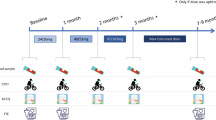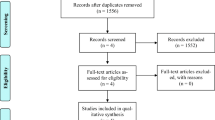Summary
Although beneficial effects of a new vasodilating agent, flosequinan, have been demonstrated in patients with severe heart failure, its efficacy has not been studied in patients with a less severe form of chronic heart failure. In this study, the effects of 4 weeks' administration of flosequinan, 50mg daily, and placebo on exercise capacity, cardiac function, and symptoms of heart failure were investigated in 24 patients with chronic mild heart failure (New York Heart Association functional class, mainly class II) in a double-blind clinical trial. When the parameter changes during the treatment period of the flosequinan and placebo groups were compared, no significant difference was found in any of the measurements except for left ventricular fractional shortening determined from M-mode echocardiograms; it was increased by 2.9 ± 1.3% in the flosequinan group whereas it was decreased by 1.3 ± 0.9% in the placebo group (P < 0.05 vs flosequinan treatment). However, when compared to baseline values, flosequinan significantly increased exercise time in the symptom-limited maximal exercise test (704 ± 103 to 763 ± 107 s,P < 0.05) and the oxygen uptake at the anaerobic threshold (13.8 ± 1.3 to 16.7 ± 1.4ml/min kg,P < 0.05), and improved symptoms assessed with a new heart failure severity classification (a median value of 2.0−1.5,P < 0.05). These improvements were not observed in the placebo group. Serious adverse effects were not observed in either group. These results suggest that flosequinan is useful for the treatment of chronic mild heart failure as well as severe heart failure.
Similar content being viewed by others
References
Franciosa JA, Weber KT, Levine TB, Kinasewitz GT, Janicki JS, West J, Henis MM, Cohn JN (1982) Hydralazine in the long-term treatment of chronic heart failure: Lack of difference from placebo. Am Heart J 104:587–594
Kramer BL, Massie BM, Topic N (1983) Controlled trial of captopril in chronic heart failure: A rest and exercise hemodynamic study. Circulation 67:807–816
Leier CV, Huss P, Magorien RD, Unverferth DV (1983) Improved exercise capacity and differing arterial and venous tolerance during chronic isosorbide dinitrate therapy for congestive heart failure. Circulation 67:817–822
Sim MF, Yates DB, Parkinson R, Cooling MJ (1988) Cardiovascular effects of the novel arteriovenous dilator agent, flosequinan, in conscious dogs and cats. Br J Pharmacol 94:371–380
Kessler PD, Packer M (1987) Hemodynamic effects of BTS 49465, a new long-acting systemic vasodilator drug, in patients with severe congestive heart failure. Am Heart J 113:137–143
Haas GJ, Binkley PF, Carpenter JA, Leier CV (1989) Central and regional hemodynamic effects of flosequinan for congestive heart failure. Am J Cardiol 63:1354–1359
Kessler PD, Packer M, Medina N, Yushak M (1988) Cumulative hemodynamic response to short-term treatment with flosequinan (BTS 49465), a new direct-acting vasodilator drug, in severe chronic congestive heart failure. J Cardiol Pharmacol 12:6–11
Cowley AJ, Wynne RD, Stainer K, Fullwood L, Rowley JM, Hampton JR (1988) Flosequinan in heart failure: Acute hemodynamic and longer term symptomatic effects. Br Med J 297:169–173
Elborn JS, Riley M, Stanford CF, Nicholls DP (1990) The effects of flosequinan on submaximal exercise in patients with chronic cardiac failure. Br J Clin Pharmacol 29:519–524
Elborn JS, Stanford CF, Nicholls DP (1989) Effect of flosequinan on exercise capacity and symptoms in severe heart failure. Br Heart J 61:331–335
Armitage P (1975) Sequential medical trials. Blackwell, Oxford
Bruce RA, Kusumi F, Hosmer D (1973) Maximal oxygen intake and nomographic assessment of functional aerobic impairment in cardiovascular disease. Am Heart J 85:546–562
Wasserman K (1987) Determinants and detection of anaerobic threshold and consequences of exercise above it. Circulation 76 (Suppl VI):29–39
Sahn DJ, DeMaria A, Kisslo J, Weyman A (1978) The committee on M-mode standardization of the American Society of Echocardiography. Recommendation regarding quantitation of M-mode echocardiography: Results of a survey of echocardiographic measurements. Circulation 58:1072–1083
Obata H, Yasuda H (1989) A guideline for the clinical evaluation of drug efficacy in congestive heart failure (in Japanese). Cardioangiology 25:257–265
Weber KT, Kinasewitz GT, Janicki JS (1982) Oxygen utilization and ventilation during exercise in patients with chronic cardiac failure. Circulation 65:1213–1223
Choong CYP, Roubin GS, Shen WF, Harris PJ, Kelly DT (1985) Effects of nefedipine on systemic and regional oxygen transport and metabolism at rest and during exercise. Circulation 71:787–796
Cowley AJ, Wynne RD, Hampton JR (1984) The effects of BTS 49465 on blood pressure and peripheral arteriolar and venous tone in normal volunteers. J Hypertens 2 (Suppl 3):547–549
Falotico R, Haertlein BJ, Lakas-Weiss CS, Salata JJ, Tobia AJ (1989) Positive inotropic and hemodynamic properties of flosequinan, a new vasodilator, and a sulfone metabolite. J Cardiol Pharmacol 14:412–418
Corin WJ, Monrad ES, Strom JA, Giustino S, Sonnenblick ES, LeJemtel T (1991) Flosequinan: A vasodilator with positive inotropic activity. Am Heart J 121:537–540
Packer M, Medina N, Yushak M (1984) Hemodynamic and clinical limitations of long-term inotropic therapy with amrinone in patients with severe heart failure. Circulation 70:1038–1044
DiBianco R, Shabetai R, Kostuk W, Moran J, Schlant RC, Wright R, for the Milrinone Multicenter Trial Group (1989) A comparison of oral milrinone, digoxin, and their combination in the treatment of patients with chronic heart failure. N Engl J Med 320:677–683
Author information
Authors and Affiliations
Additional information
Authors for the Osaka Flosequinan Multicenter Trial Group, members of which are listed in the Appendix
Rights and permissions
About this article
Cite this article
Hori, M., Sato, H., Ozaki, H. et al. Effect of flosequinan on exercise capacity and cardiac function in patients with chronic mild heart failure: A double-blind placebo-controlled study. Heart Vessels 7, 133–140 (1992). https://doi.org/10.1007/BF01744866
Received:
Revised:
Accepted:
Issue Date:
DOI: https://doi.org/10.1007/BF01744866




